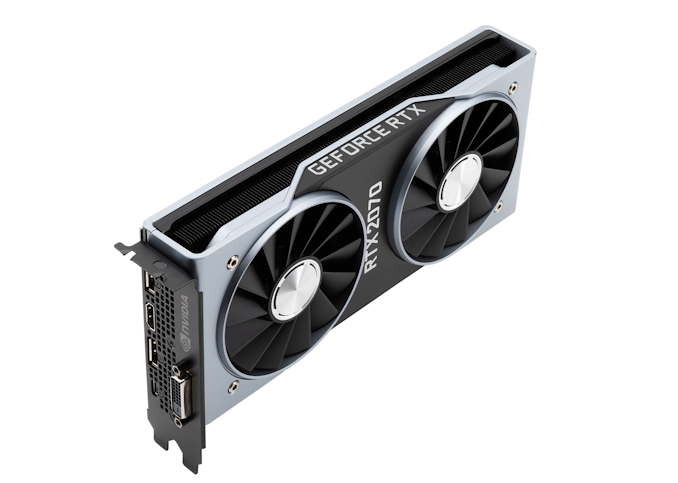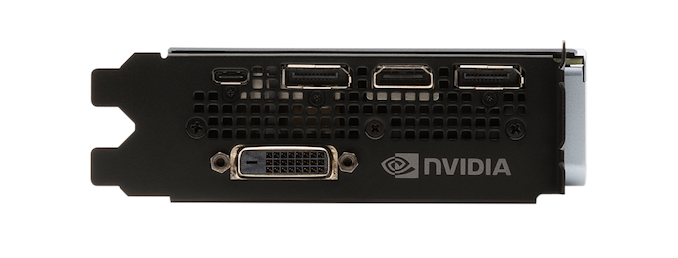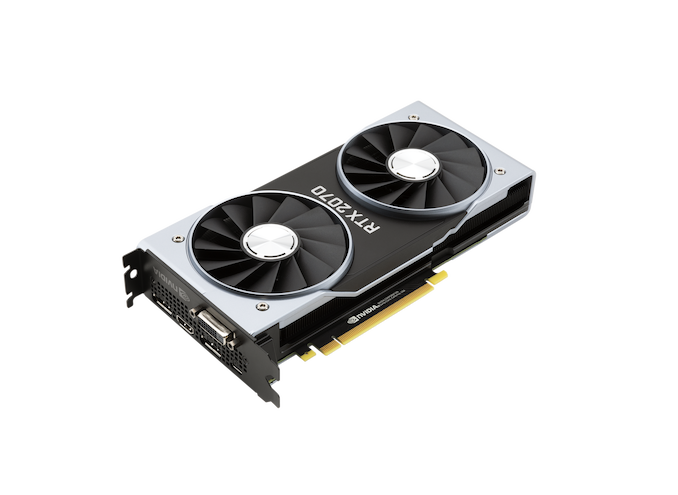The NVIDIA GeForce RTX 2070 Founders Edition Review: Mid-Range Turing, High-End Price
by Nate Oh on October 16, 2018 9:00 AM ESTMeet The GeForce RTX 2070 Founders Edition Card
Touching quickly on the card itself, there's little we haven't already seen with the RTX 2080 Ti and 2080 Founders Editions. The biggest change is, of course, a new open air cooler design. Along with the Founders Edition specification changes of +10W TDP and +90 MHz boost clockspeed, the cards might be considered 'reference' in that they remain a first-party video card sold direct by NVIDIA, but strictly-speaking they are not because they no longer carry reference specifications.
Wrapped in the flattened industrial design introduced by the other RTX cards, the RTX 2070 Founders Edition looks essentially the same, save a few exceptions. The single 8-pin power connector is at the front of the card, while the NVLink SLI connectors are absent as the RTX 2070 does not support SLI. Internally, the dual 13-blade fans accompany a vapor chamber, while a 6-phase system provides the power for the 185W TDP RTX 2070 Founders Edition.
So while the single 8-pin configuration, suitable for up to 225W total draw, has remained the same from the GTX 1070, the TDP has not. The RTX 2070 Founders Edition brings 185W, with reference specification at 175W, compared to the 150W GTX 1070 and 145W GTX 970, following the trend of the 2080 Ti and 2080 pushing up the watts.
As for I/O, there is one difference between the 2070 and its older siblings. The RTX 2070 Founders Edition drops the isolated DisplayPort for a DVI port, matching the GTX 1070's outputs. This is in addition to DisplayPort 1.4 and DSC support, the latter of which is part of the DP1.4 spec, as well as the VR-centric USB-C VirtualLink port, which also carries an associated 30W not included in the overall TDP. While the past few years have seen DVI excised from the top-end cards, it's more of a matter of practicality for mid-range cards (inasmuch as $500 is a midrange price) that are often paired with budget DVI monitors, particularly as a drop-in upgrade for an aging video card.
As mentioned in the RTX 2080 Ti and 2080 launch article, something to note is the potential impact on OEM sales with this reference design change. The RTX 2070 also arrives as an open air design and so can no longer guarantee self-cooling independent of chassis airflow. In addition to the price and lower volume nature of these GPU parts, these aspects make the RTX reference cards less suitable for large OEMs.














121 Comments
View All Comments
hansmuff - Tuesday, October 16, 2018 - link
Great review making some very pointed and smart commentary. Thank you!Hixbot - Tuesday, October 16, 2018 - link
Nvidia are not even interested in competing with themselves.shabby - Tuesday, October 16, 2018 - link
It's hilarious in a way, take the tensor cores and ray tracing out of the equation and there's barely any difference between pascal and Turing. It's almost like that extra memory bandwidth is giving Turing its speed bump and nothing more.PeachNCream - Tuesday, October 16, 2018 - link
NVIDIA is heavily marketing ray tracing as the killer feature for the RTX cards. Its clear that a generational gain in performance wasn't in the cards (pun intended) this time around.shabby - Tuesday, October 16, 2018 - link
And with Ray tracing turned on these things will perform like cards from 4 years ago. Nvidias going back to the future.AshlayW - Tuesday, October 16, 2018 - link
So in Far Cry 5, a game that I play a lot, I've essentially got RTX 2070 performance with my Vega 56 (OC+ Flashed to 64), but for £399 and the game free with it? Cool!The_Assimilator - Tuesday, October 16, 2018 - link
But you also need a small nuclear reactor to power it and a moderately-sized dam to cool it, so there's that.Spunjji - Wednesday, October 17, 2018 - link
If you run your computer for anything like sensible periods of time, that extra power draw still doesn't come close to amounting to the price difference. Remember, you have to consider it in context of the power draw of your entire home.pixelstuff - Tuesday, October 16, 2018 - link
I think my price limit on GPUs is the "not much more than an entire gaming console with slightly better performance" bracket of $350-400. I guess we'll see if the 2060 fits that bill and makes a worthy upgrade to the 970. Otherwise I'll be waiting one extra generation this time around instead of upgrading every other generation.Icehawk - Tuesday, October 16, 2018 - link
I’m with the crowd that says wtf to the new pricing - I’m a 670>970 owner and was hoping to upgrade to another x70 for $350-400 but they are priced too high for me now to justify. Hope they bring prices back to reality for the 2170 or that they offer GTX models along with RTX.If they want to shift the cards up a rank, IMO, they should have adjusted the naming schema.